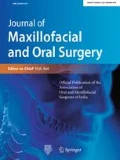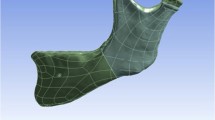Abstract
Aim of the study
The present study compares lingual stability of monocortical miniplate fixation with that of bicortical miniplate fixation in parasymphysis fracture using FEM analysis.
Materials and methods
Using multislice CT scanner, 3D FEM of patient’s mandible was created. Fracture was simulated at parasymphysis region and fixed with 2-mm titanium miniplates and screws of length 8, 10, 12 mm, respectively. Loading force of 120 N applied at molar region and 62.8 N at incisor region. These three models were imported into ANSYS Workbench FEM software.
Result
There is no significant difference in results between bicortical fixation and monocortical fixation.
Conclusion
It was concluded that use of monocortical fixation provides sufficient lingual stability. This suggests monocortical fixation system is as reliable as bicortical fixation.






Similar content being viewed by others
References
Hart RT, Hennebel VV, Thongpreda N et al (1992) Modeling the biomechanics of the mandible: a three-dimensional finite element study. J Biomech 25:261
KoriothTW VersluisA (1997) Modeling the mechanical behavior of the jaws and their related structures by finite element (FE) analysis. Crit Rev Oral Biol Med 8:90
Fernandez JR, Gallas M, Burquera M, Viano JM (2003) A three-dimensional numerical simulation of mandible fracture reduction with screwed miniplates. J Biomech 36:329–337
Wagner A, Krach W, Schicho K, Undt G, Ploder O, Ewers R (2002) A 3-dimensional finite-element analysis investigating the biomechanical behavior of the mandible and plate osteosynthesis in cases of fractures of the condylar process. Oral Surg Oral Med Oral Pathol Oral Radiol Endod 94:678–686
Lovald ST, Wagner JD, Baack B (2009) Biomechanical optimization of bone plates used in rigid fixation of mandibular fractures. J Oral Maxillofac Surg 67:973–985
Lovald ST, Khraishi T, Wagner J, Baack B, Kelly J, Wood J (2006) Comparison of plate-screw systems used in mandibular fracture reduction: finite element analysis. J Biomech Eng 128:654–662
Joshi U, Kurakar M (2014) Comparison of stability of fracture segments in mandible fracture treated with different designs of mini-plates using FEM analysis. J Maxillofac Oral Surg 13(3):310–319
Iseri H, Tekkaya E, Oztan O, Bilgic S (1998) Biomechanical effects of rapid maxillary expansion on the craniofacial skeleton studied by the finite element method. Eur J Orthod 20:347–356
Chuong CJ, Borotikar B, Schwartz-Dabney C, Sinn DP (2005) Mechanical characteristics of the mandible after bilateral sagittal split ramus osteotomy: comparing 2 different fixation techniques. J Oral Maxillofac Surg 63:68–76
Korkmaz HH (2007) Evaluation of different mini-plates in fixation of fractured human mandible with the finite element method. Oral Surg Oral Med Oral Pathol Oral Radiol Endod 103:1–13
Van Eijden TMGJ, Korfage JAM, Brugma P (1997) Architecture of the human jaw: closing and jaw-opening muscles. Anat Rec 248:464–474
Meijer HJA, Starmans FJM, Bosman F, Sten WHA (1993) A comparison of three finite element models of an edentulous mandible provided with implants. J Oral Rehab 20:147–157
Tate G, Ellis E III, Throckmorton GS (1994) Bite forces in patients treated for mandibular angle fractures. J Oral Maxillofac Surg 52:734–736
ANSYS—Engineering Analysis System (1989) Theoretical manual- theory reference. Swanson Analysis Systems, Canonsburg
Perren SM (1979) Physical and biological aspects of fracture healing with special reference to internal fixation. Clin Orthop 138:175
Spiessl B (1989) Internal fixation of the mandible: a manual of AO/ASIF principles. Springer, Berlin
Michelet FX, Deymes J, Dessus B (1973) Osteosynthesis with miniaturized screwed plates in maxillofacial surgery. J Maxillofac Surg 1:79–84
Champy M, Lodde JP, Schmitt R et al (1978) Mandibular osteosynthesis by miniature screwed plates via a buccal approach. J Maxillofac Surg 6:14–21
Schwyer HK, Cordey J, Brun S et al (1985) Bone loss after internal fixation using plates determination in humans using computed tomography. In: Perren SM, Schneider E (eds) Biomechanics: current interdisciplinary research. Nijhoff, Dordrecht, p 191
Kerawala CJ, Allan W, Williams ED (2003) Can monocortical miniplates provide bony compression? An experimental model. Br J Oral Maxillofac Surg 41:232–235
Raveh J, Vuillemin T, Ladrach K et al (1987) Plate osteosynthesis of 367 mandible fractures. J Craniomaxillofac Surg 15:244–253
Braut V, Bornstein MM, Kuchler U, Buser D (2014) Bone dimensions in the posterior mandible: a retrospective radiographic study using CBCT. Part 2; analysis of edentulous site. Int J Periodontics Restorative Dent 34(5):639–647
Tams J, Van Loon JP, Rozema FR et al (1996) A three-dimensional study of loads across the fracture for different fracture sites of the mandible. Br J Oral Maxillofac Surg 34:400–404
Ji B, Wang C, Liu L et al (2010) A biomechanical analysis of titanium miniplates used for treatment of mandibular symphyseal fractures with the finite element method. Oral Surg Oral Med Oral Pathol Oral Radiol Endod 109:e21
Arbag H, Korkmaz HH, Ozturk K et al (2008) Comparative evaluation of different miniplates for internal fixation of mandible fractures using finite element analysis. J Oral Maxillofac Surg 66:1225
Andersen KL, Pedersen EH, Melsen B (1991) Material parameters and stress profiles within the periodontal ligament. Am J Orthod Dentofacial Orthop 99:427
Harada K, Watanabe M, Ohkura K, Enomoto S (2000) Measure of bite force and occlusal contact area before and after bilateral sagittal split rams osteotomy of the mandible using a new pressure- sensitive device. A preliminary report. J Oral Maxillofac Surg 58:370–373
Giri KY, Sahu P, Rastogi S, Dandriyal R, Mall S, Singh AP, Indra BNP, Singh HP (2015) Bite force evaluation of conventional plating system versus locking plating system for mandibular fracture. J Maxillofac Oral Surg 14(4):972–978
Tams J, van Loon J-P, Otten E et al (1997) A three-dimensional study of bending and torsion moments for different fracture sites of the mandible: an in vitro study. Int J Oral Maxillofac Surg 26:383
Sugiura T, Yamamoto K, Murakami K et al (2009) Biomechanical analysis of miniplate osteosynthesis for fractures of the atrophic mandible. J Oral Maxillofac Surg 67:2397
Author information
Authors and Affiliations
Corresponding author
Ethics declarations
Conflict of interest
Dr. Udupikrishna Joshi and Dr. Manju Kurakar declare that we have no conflict of interest in this study.
Informed Consent
This article does not contain any studies with human participants or animals performed by any of the authors. For this type of study, formal consent is not required.
Rights and permissions
About this article
Cite this article
Joshi, U., Kurakar, M. Assessment of Lingual Stability in Mandible Fracture: Monocortical Versus Bicortical Fixation Using FEM Analysis. J. Maxillofac. Oral Surg. 17, 514–519 (2018). https://doi.org/10.1007/s12663-017-1073-0
Received:
Accepted:
Published:
Issue Date:
DOI: https://doi.org/10.1007/s12663-017-1073-0




